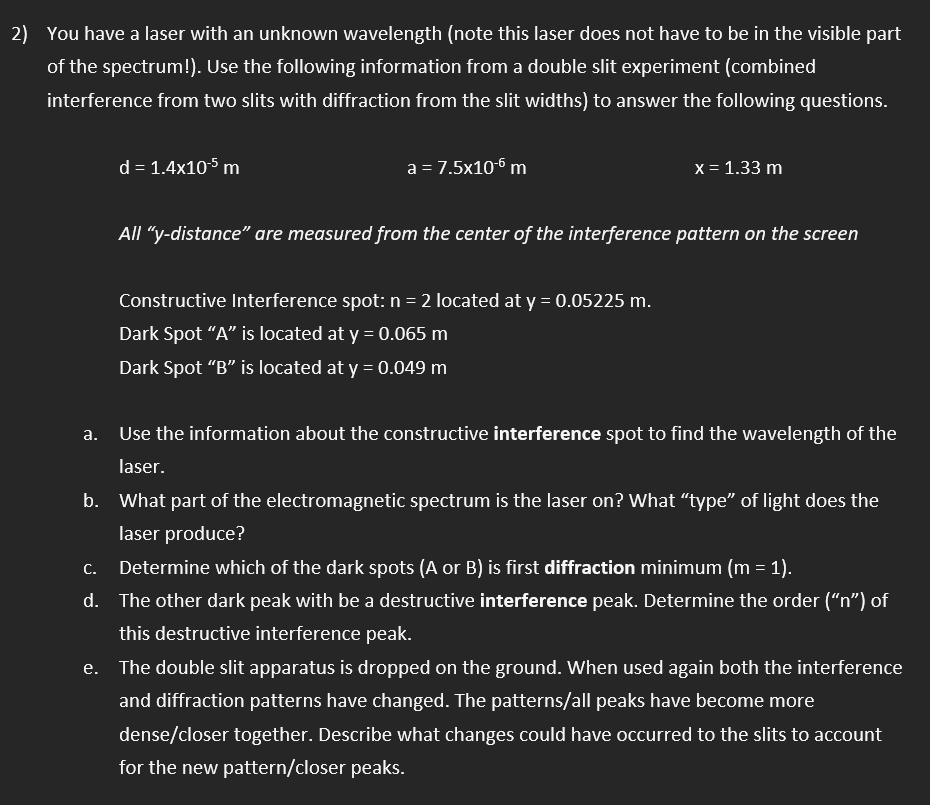2) You have a laser with an unknown wavelength (note this laser does not have to be in the visible part of the spectrum!). Use the following information from a double slit experiment (combined interference from two slits with diffraction from the slit widths) to answer the following questions. d = 1.4x105 m a = 7.5x10-6 m x = 1.33 m All "y-distance" are measured from the center of the interference pattern on the screen Constructive Interference spot: n = 2 located at y = 0.05225 m. Dark Spot “A" is located at y = 0.065 m Dark Spot “B" is located at y = 0.049 m Use the information about the constructive interference spot to find the wavelength of the laser. b. What part of the electromagnetic spectrum is the laser on? What "type" of light does the laser produce? С. Determine which of the dark spots (A or B) is first diffraction minimum (m = 1). The other dark peak with be a destructive interference peak. Determine the order (“n") of this destructive interference peak. The double slit apparatus is dropped on the ground. When used again both the interference and diffraction patterns have changed. The patterns/all peaks have become more dense/closer together. Describe what changes could have occurred to the slits to account for the new pattern/closer peaks.
2) You have a laser with an unknown wavelength (note this laser does not have to be in the visible part of the spectrum!). Use the following information from a double slit experiment (combined interference from two slits with diffraction from the slit widths) to answer the following questions. d = 1.4x105 m a = 7.5x10-6 m x = 1.33 m All "y-distance" are measured from the center of the interference pattern on the screen Constructive Interference spot: n = 2 located at y = 0.05225 m. Dark Spot “A" is located at y = 0.065 m Dark Spot “B" is located at y = 0.049 m Use the information about the constructive interference spot to find the wavelength of the laser. b. What part of the electromagnetic spectrum is the laser on? What "type" of light does the laser produce? С. Determine which of the dark spots (A or B) is first diffraction minimum (m = 1). The other dark peak with be a destructive interference peak. Determine the order (“n") of this destructive interference peak. The double slit apparatus is dropped on the ground. When used again both the interference and diffraction patterns have changed. The patterns/all peaks have become more dense/closer together. Describe what changes could have occurred to the slits to account for the new pattern/closer peaks.
College Physics
10th Edition
ISBN:9781285737027
Author:Raymond A. Serway, Chris Vuille
Publisher:Raymond A. Serway, Chris Vuille
Chapter24: Wave Optics
Section: Chapter Questions
Problem 68AP
Related questions
Question
Please solve A-E

Transcribed Image Text:2) You have a laser with an unknown wavelength (note this laser does not have to be in the visible part
of the spectrum!). Use the following information from a double slit experiment (combined
interference from two slits with diffraction from the slit widths) to answer the following questions.
d = 1.4x10-5 m
a = 7.5x10-6 m
x = 1.33 m
All "y-distance" are measured from the center of the interference pattern on the screen
Constructive Interference spot: n = 2 located at y = 0.05225 m.
Dark Spot "A" is located at y = 0.065 m
Dark Spot “B" is located at y = 0.049 m
а.
Use the information about the constructive interference spot to find the wavelength of the
laser.
b. What part of the electromagnetic spectrum is the laser on? What "type" of light does the
laser produce?
С.
Determine which of the dark spots (A or B) is first diffraction minimum (m = 1).
d.
The other dark peak with be a destructive interference peak. Determine the order ("n") of
this destructive interference peak.
The double slit apparatus is dropped on the ground. When used again both the interference
and diffraction patterns have changed. The patterns/all peaks have become more
dense/closer together. Describe what changes could have occurred to the slits to account
for the new pattern/closer peaks.
Expert Solution
This question has been solved!
Explore an expertly crafted, step-by-step solution for a thorough understanding of key concepts.
Step by step
Solved in 3 steps

Knowledge Booster
Learn more about
Need a deep-dive on the concept behind this application? Look no further. Learn more about this topic, physics and related others by exploring similar questions and additional content below.Recommended textbooks for you

College Physics
Physics
ISBN:
9781285737027
Author:
Raymond A. Serway, Chris Vuille
Publisher:
Cengage Learning

Physics for Scientists and Engineers, Technology …
Physics
ISBN:
9781305116399
Author:
Raymond A. Serway, John W. Jewett
Publisher:
Cengage Learning

College Physics
Physics
ISBN:
9781305952300
Author:
Raymond A. Serway, Chris Vuille
Publisher:
Cengage Learning

College Physics
Physics
ISBN:
9781285737027
Author:
Raymond A. Serway, Chris Vuille
Publisher:
Cengage Learning

Physics for Scientists and Engineers, Technology …
Physics
ISBN:
9781305116399
Author:
Raymond A. Serway, John W. Jewett
Publisher:
Cengage Learning

College Physics
Physics
ISBN:
9781305952300
Author:
Raymond A. Serway, Chris Vuille
Publisher:
Cengage Learning

University Physics Volume 3
Physics
ISBN:
9781938168185
Author:
William Moebs, Jeff Sanny
Publisher:
OpenStax

College Physics
Physics
ISBN:
9781938168000
Author:
Paul Peter Urone, Roger Hinrichs
Publisher:
OpenStax College

Physics for Scientists and Engineers with Modern …
Physics
ISBN:
9781337553292
Author:
Raymond A. Serway, John W. Jewett
Publisher:
Cengage Learning